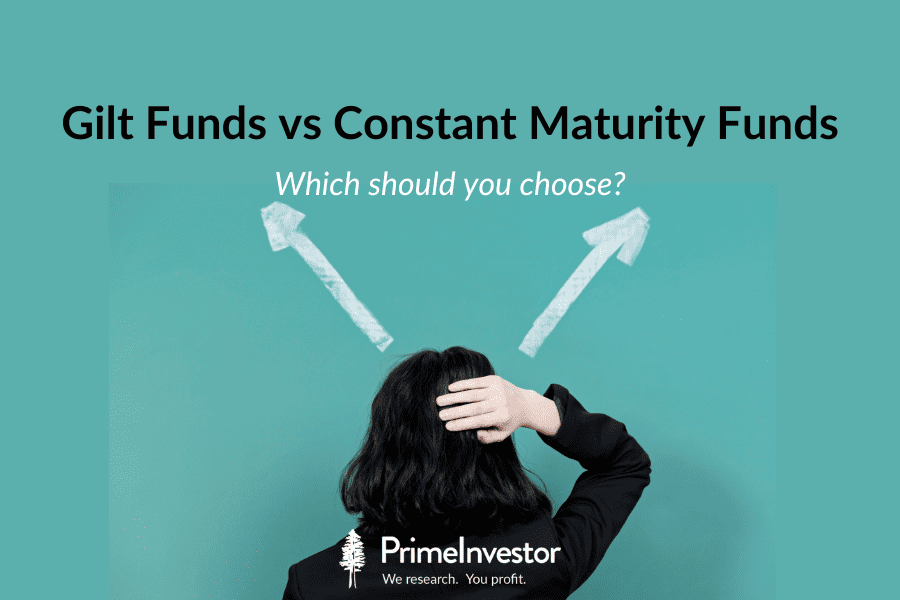If there is one fairly common confusion with debt funds, it is whether a gilt fund is better or a constant maturity fund. Add in a long duration fund and the confusion compounds. So, which of these should you go for and what purpose do these funds serve? Here’s explaining all you need to know.

Back to basics
There are both portfolio commonalities between these three fund categories and differences in the way they are managed. SEBI’s definition of these fund categories are as follows:
- Gilt funds invest in central (G-Secs) and state government bonds (SDLs) only. There are no restrictions on the maturity of their portfolio. This means funds will change portfolio maturities based on their view on the rate cycle and yields in different tenors. Each gilt fund can take a different view and will adapt their portfolio as the rate cycle progresses.
- Gilt funds with constant maturity also invest in G-Secs and SDLs. However, the fund’s duration needs to be always managed at 10 years. Funds can hold bonds of different maturities in a manner that the portfolio as a whole remains around 10 years.
- Long duration funds can invest in both corporate/bank or central/state government bonds. However, these funds need to maintain maturities at 7 years or longer. Given that funds typically avoid locking into such long-term corporate bonds, most long duration funds tend to hold the bulk of their portfolio only in SDLs and G-secs.
So where do the similarities come from? Before we get there, note that there are two ways in which debt funds make returns. One, from earning interest income on bonds held, called an accrual strategy. Two, earning returns through bond price appreciation when interest rates fall, called a duration strategy.
Read more about the accrual strategy and duration strategy in Prime Varsity:
Let’s first see the similarities between gilt funds, long duration funds and constant maturity funds.
- The first similarity is that they all invest in G-Secs an SDLs.
- Second, they are low on credit risk since they predominantly invest in government securities and state loans.
- Third, and very importantly, these categories primarily see a good part of returns come from a duration strategy. G-Secs are more sensitive to changes in the rate cycle compared to corporate bonds and are therefore well-suited for a duration strategy.
- Fourth, given that interest on gilts especially will typically be lower than corporate bonds, relying on interest accrual alone will result in sub-par returns. These funds rely on capital appreciation opportunities to generate returns (duration strategy seeks to achieve this).
- Fifth, owing to both the strategy and the longer portfolio maturity, funds in these three debt categories are also more volatile than other categories.
- The final similarity between gilt, constant maturity and long duration funds is that they are best used in long-term portfolios of at least 4-5 years to allow the strategy to play out and volatility to even out. For all these reasons, we club these categories together to arrive at Prime Ratings.
Performance of categories
Gilt funds have been around for a very, very long time. Long duration funds, though, was a category that was created in SEBI’s new categorisation rules in 2017. Constant maturity funds as a category, too, was introduced only then; however, there already were funds that had a strategy of maintaining a steady 10-year maturity and these simply slotted themselves into the constant maturity category.
In the long duration category, the funds are even newer. Of the seven current long duration funds, 5 were launched only in the past couple of years. The rate cycle has been rising to flat in this period, making it very hard to judge how this category would do in longer-term returns and ability to deliver across rate cycles.
That leaves gilt funds and constant maturity funds. The table below captures the averages of the two categories.
From this data, you may be tempted to quickly conclude that gilt funds are the better option. However, there are a few points to note.
- Averages mask differentials in returns. For example, if we were to remove a DSP Constant Maturity fund for its poor recent performance, the average 3-year return jumps to 7.10% and the 5-year return moves up to 8.5%. Similarly, within the gilt category, average 3-year returns have been as low as 5.6% (Franklin India Govt Securities) to as good as 8% (Edelweiss G-Sec).
- Gilt fund returns depend on the fund manager’s view on the rate cycle, how actively the duration is accordingly managed and the most attractive opportunities on the yield curve. This makes each fund different from the other in terms of both returns and volatility. For example, consider the very short-term 3-month returns to judge the impact of any yield changes on a fund – some gilt funds have dropped over 2% while others have dropped less than 1%.
- Measured against short-term volatility, long duration funds are slightly higher than constant maturity funds and much more than gilt funds. Remember that long duration funds cannot dip below the 7-year duration mark (unlike gilt funds which have no duration restriction); longer maturities are more sensitive to the interest rate environment.
Gilt funds vs constant maturity funds
When weighing choices between gilt vs constant maturity vs long duration, predictability is the single factor tilting the scale in favour of constant maturity funds.
All funds aim to gain from bond price appreciation. However, with gilt funds, there is no way to predict what view the scheme’s manager would take on the rate cycle. There can be widely differing takes within the category. For example, in January 2024 the average maturity of gilt funds ranges from 3 years to 24 years. In June 2023, after which the RBI went on rate pause, the range was between 4 to 10 years. And in early 2022, before the RBI went on its hiking spree, it ranged between 2 and 13 years.
Some funds may excel at containing downsides by reducing maturity during rate shifts while others may adopt an aggressive stance. Not just this. Even within the same fund, the maturity can fluctuate sharply from month-to-month, making it harder to judge what strategy the fund manager may be trying to adopt.
This has two implications.
- One, any wrongly-timed call can hurt returns or keep returns subdued. It’s hard for debt funds to bounce back from mistimed duration calls.
- Two, it means that there could be a mismatch between your purpose behind investing in that fund and what it does in reality. Let’s say you may intend to invest in a gilt fund to gain from a possible falling rate cycle. The fund, though, may take the view that rate cuts are a way off and maintain a short maturity profile. In such a case, the fund may not be suitable for your investment objective.
In comparison, constant maturity funds are extremely predictable as they keep maturity steady. It’s possible to both understand the extent of volatility and weather it, and make timed calls to play duration. In other words, the ‘passive duration nature’ of constant maturity funds means there is one factor that is known at all times.
While long duration funds can also theoretically fit the predictability requirement, the lack of performance data and fund choices makes it difficult to rely on these funds.
So, what should you do if you have to decide between gilt funds and constant maturity? Use the following pointers:
- If you’re looking specifically for a tactical investment strategy – that is, you invest when yields are high in order to gain the most from bond price appreciation when yields eventually fall, then a gilt fund with high maturity holds potential to deliver the most provided the rate fall happens as expected. The only risk is that if you take a call rather early on a gilt fund and the fund manager thinks otherwise and reduces the fund’s maturity, then the fund will no longer serve your purpose. It is for this reason (certainty of duration) we generally prefer constant maturity funds, even though it cannot go beyond 10 years (higher the maturity higher the capital appreciation in a rate fall scenario).
- If you’re simply looking for a high-quality credit option to add to your debt portfolio – that is, you simply want to invest and hold debt for the long term. In this case, you can go with either gilt funds or constant maturity funds. Both will be fine. However, ensure that you choose a consistent performer that has beaten the category average in 3-year or 5-year periods. You can use our MF Rolling Return Calculator, MF Screener, or MF Rolling Return vs category tools for this. You can also pick funds with a Buy call in the MF Review Tool.
- If you’re looking for funds investing in gilts that are not volatile – that is, you want low risk, high-creditworthy funds, then it might disappoint you to know that there are no short-term gilt funds with a stated short-term strategy. They are all go-anywhere funds. If it’s low volatility that you are after, categories such as short duration funds, banking & PSU debt funds, floating rate funds, or money market funds that have low credit risk are better fits.
Whichever fund of the three categories – gilt, constant maturity or long duration – you choose, remember that returns will be volatile in the short term and that these funds are suitable only for long-term portfolios. In Prime Funds, we house gilt and constant maturity recommendations under Debt – Long Term.




12 thoughts on “Gilt funds vs constant maturity funds – which should you choose?”
1) If one wants during accumulation phase to invest in Debt instruments with investment horizon of 20 yrs(accumulation period) what strategy you would suggest.
key points in this: 1 absolutely sure that funds not required before 20 yrs and there after in phases over next 10 yrs
2. Not worried about volatility in between.
3. While returns will not be certain, there must be some way to predict expected returns
4. Minimize tax impact
Can constant10 yr maturity guilt fund can be held beyond 10 yrs and what happens to return in that case as duration strategy may or may not work
1. A mix of short and long debt funds (laddering it is called)
3. Predictability is always a challenge..at best the cycle turns can be predicted as there are too many extraneous factors in debt (economy, global rates, currency, liquidity etc) Not long-term returns.
4. Not possible any more.
Yes constant maturity can be held for anytime. They are not roll down strategies (where maturity decreases with time) but constant. es, when rates go up, they are hurt. When rates fall they benefit.
Dynamic Bond Fund categories are less volatile as compared to pure gilt/long duration fund. I see that lot of dynamic bond funds have taken higher exposure (compared to historical) to gilts of late eg: bandhan and ITI and combined with lower duration papers they give stability to the portfolio in the event of delay in rate cuts.
Dynamic bond funds switch between duration and accrual strategies. They therefore have a similar risk – that the call on the rate cycle goes wrong. So they have both the risk that they get the duration play wrong, but also the switch between duration & accrual. So we don’t typically recommend dynamic bond funds. – thanks, Bhavana.
Great ! I remember your article last year or before and happy that I have invested in sbi content maturity fund as part of my core debt portfolio , I will patient enough to hold it for 10 years !
Great! – regards, Bhavana
Last point says that there are no short term gilts funds. Edel MF had promoted a Short duration gilt some 2 yrs back. Am I missing something?
Assuming you mean the Edelweiss CRISIL IBX 50:50 Gilt Plus SDL Short Duration Index Fund – this is fine, but it is among the only option and therefore not much of a choice. You can invest in it if you specifically want short maturity gilt. – thanks, Bhavana
“If you’re looking for funds investing in gilts that are not volatile” – would you consider Edelweiss CRISIL IBX 50:50 Gilt Plus SDL Short Duration Index Fund in this category? It has an average maturity of around 3 years. Do you feel that it may be significantly volatile?
These funds will be target maturity funds – they will mature/close at the end of the period. So if you hold to maturity, the volatility does not matter and you will earn yields close to what was prevailing at the time of your investment. Not sure which fund you are referring to here, but shorter tenors will not see much volatility. Target maturity funds are different from gilt/constant maturity funds; there is no concept of maturity in the latter and can be held for however long it is you want. – regards, Bhavana
Good article to understand.
Just want to ask how shud be the allocation in debt? Out of overall debt allocation, how much percentage in short term (money market and liquid), medium term and long term Funds?
Thanks in advance
Your debt allocation will depend on your risk/timeframe. To get an idea, you can try our Build Your Own Portfolio tool which will give a break up of equity & debt, and within debt, break up between long & short duration. – regards, Bhavana
Comments are closed.